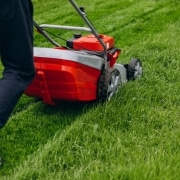It’s Grass-Mowing Season: Use These Top Tips for Preventing Heel Pain
Springtime rolls around every year, and if you’re using a push mower to cut your grass, it may feel like most of the rolling happens over your feet. Heel pain can be just as much a harbinger of spring as the sighting of the first tulip in bloom. So take the advice of your podiatrist in Austin, TX, and use these timeless tips to make that springtime yard work a little less painful.
Wear the Right Shoes
Yardwork like mowing and trimming can put real stress on your feet. You may end up with heel pain, blisters, and more. For these reasons, it’s important to find shoes that are compatible with outdoor work. Choose ones with good tread to prevent slipping, a water-resistant coating to keep feet dry and comfortable, and plenty of padding. Make sure they fit well and don’t crowd your toes, either.
Wear the Right Socks, Too
You probably never think about your socks, but they’re just as important as shoes when it comes to preventing heel pain. Compression socks are a good choice for preventing problems such as heel pain, swelling, and inflammation because they apply pressure, which supports the arches of your feet. They also help to increase blood flow to the area.
Do Some Warm-Ups Before Working Out on your Grass
Mowing grass is a pretty physical activity, especially when you’re using a mower that’s not self-propelled. This means you need to stretch and warm up beforehand, just as you would before hitting the gym or the jogging trail. Just a few minutes spent stretching your calf muscles and Achilles tendon may be enough to save you from the discomfort of heel pain.
Find Help for Heel Pain in Austin, TX
If you need help with heel pain in Austin or Pflugerville, TX, Dr. Jeffery W. LaMour is just a phone call away. Contact us today to schedule your consultation.








